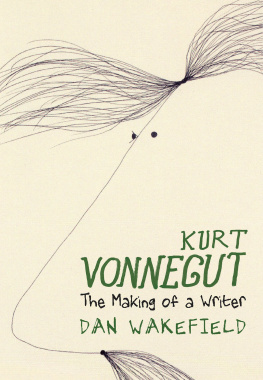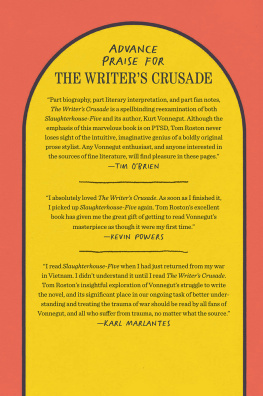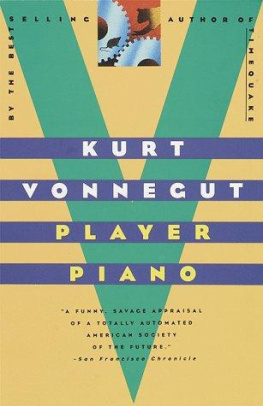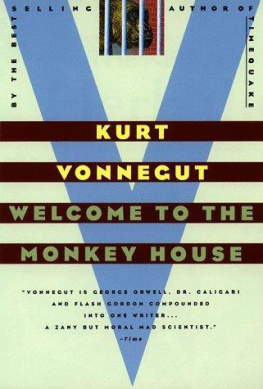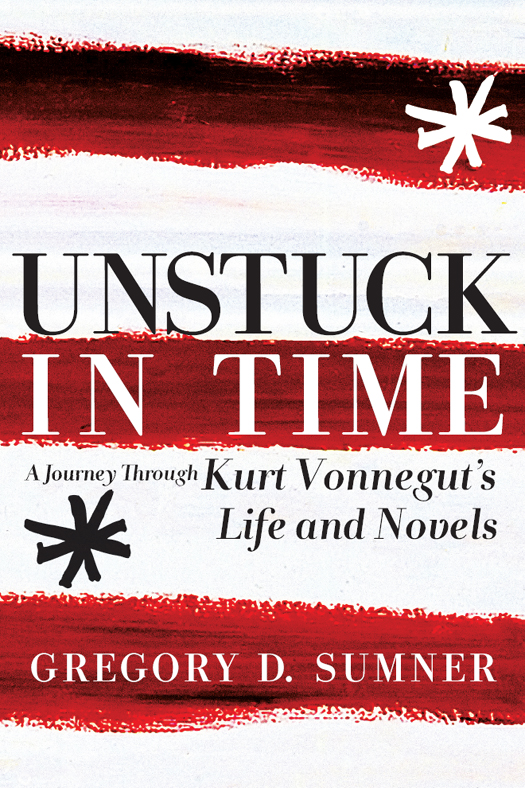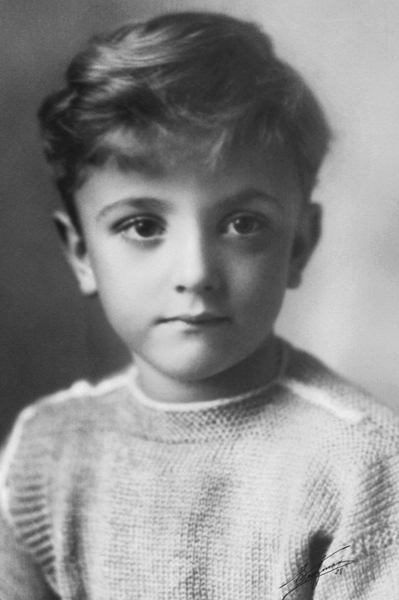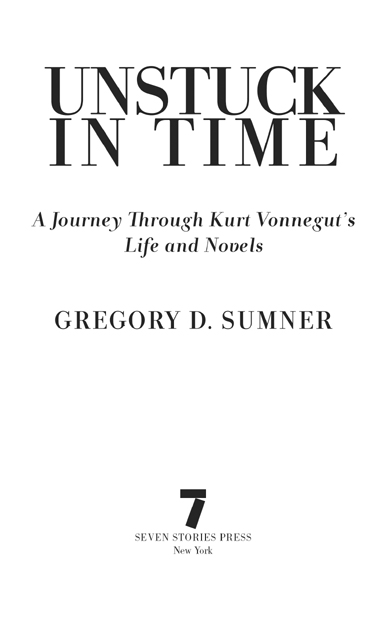Copyright 2011 by Gregory D. Sumner
All rights reserved. No part of this book may be reproduced, stored in a retrieval system, or transmitted in any form, by any means, including mechanical, electronic, photocopying, recording, or otherwise, without the prior written permission of the publisher.
College professors may order examination copies of Seven Stories Press titles for a free six-month trial period. To order, visit www.sevenstories.com/textbook or send a fax on school letterhead to (212) 226-1411.
Contents
INTRODUCTION
Storyteller: Kurt Vonnegut
and the American Dream
PROLOGUE
Impossible Dreams: A Writers Education, 19221952
ONE
Player Piano
TWO
The Sirens of Titan
THREE
Mother Night
FOUR
Cats Cradle
FIVE
God Bless You, Mr. Rosewater, or, Pearls Before Swine
SIX
Slaughterhouse-Five, or, The Childrens Crusade:
A Duty-Dance with Death
SEVEN
Breakfast of Champions, or, Goodbye Blue Monday!
EIGHT
Slapstick, or, Lonesome No More!
NINE
Jailbird
TEN
Deadeye Dick
ELEVEN
Galpagos: A Second Noahs Ark
TWELVE
Bluebeard
THIRTEEN
Hocus Pocus
FOURTEEN
Timequake
EPILOGUE
A Man without a Country, a Planetary Citizen
List of Illustrations
: Kurt Vonnegut, circa 1928. Courtesy of Nanny Vonnegut
: Newlyweds Kurt and Jane Vonnegut, 1951. Courtesy of Nanny Vonnegut
: Kurt and Nanny Vonnegut, 1958. Courtesy of Nanny Vonnegut
: Kurt Vonnegut, 1965. Bob Doeppers/The Indianapolis Star
: Left to right: Nanny Vonnegut, Kurt Adams, Steve Adams, Edith Vonnegut, Kurt Vonnegut at Niagara Falls, 1965. Courtesy of Nanny Vonnegut
: At a press luncheon at the 21 Club, circa 1967, for CBS Filmss Virtues, are the pictures producers and five of its eight writers. Producers (standing, left to right): Si Litvinoff, Francis Ford Coppola, and Raymond Wagner. Writers (seated left to right): Jack Gelber, Bruce Jay Friedman, Paul Krassner, and Kurt Vonnegut. The Film Daily
: Kurt Vonnegut at his home in Barnstable, Cape Cod, 1969. Israel Shenker/Getty
: Kurt Vonnegut, 1971. Fred W. McDarrah/Getty
: Kurt Vonnegut, 1975. Bernard Gotfryd/Getty
: Kurt Vonnegut in New York, 1979. Mary Reichenthal/AP Photo
: Kurt Vonnegut at Manchester University, 1983. Kevin Cummins/Getty
: Kurt Vonnegut at his home, 1985. Oliver Morris/Getty
: Kurt Vonnegut with Jill Krementz and Lilly, 1987. Allen Ginsberg/CORBIS
: Kurt Vonnegut, 1990. Ron Galella/Getty
: Kurt Vonnegut attends NY Film Festival premier, 1999. Gregory Pace/CORBIS
: Editorial cartoon by John Sherffius, April 12, 2007. 2007 by John Sherffius. Used by permission of John Sherffius and Creators Syndicate, Inc.
Preface
Kurt Vonnegut was generous in our correspondence more than a decade ago, when I broached a fledgling aspiration to write about his life. He wrote back telling me that he liked my study of the muckraking New York critic Dwight Macdonald, an exemplar of perfect political decency he knew a little and admired, along with Orwell, as a figure from the golden age of romantic anti-fascism. With a teachers gentle hand he cautioned that the biography I imagined undertaking would not be an easy thing to accomplish. You would find yourself trying to tell a story with only one character, with no supporting cast, no gang, Mr. Vonnegut explained. He continued, with typical humility and even embarrassment:
I was once hired to write a scenario based on The French Lieutenants Woman. I had to give up, because everything was in peoples heads. In the world of the senses, absolutely nothing happened. My life has been pretty much like that.
So I decided to tell Kurt Vonneguts story by walking across the foundation stones of his legacy, his fourteen novels. Written under dramatically changing personal circumstances, against the backdrop of seismic shifts in our countrys historical circumstances, they read together as a kind of diary, an impassioned and sometimes brokenhearted meditation on the American Dream. I hope he would forgive me the conceit of trying to explain his art, and that this companion to his life and books is in some measure faithful to Vonneguts spirit, which continues to inspire so many readers of all ages.
When I find a well-drawn character in fiction or
biography, I generally take a warm personal
interest in him, for the reason that I have known
him beforemet him on the river.
MARK TWAIN
The function of an artist is to respond
to his own time.
KURT VONNEGUT
INTRODUCTION
Storyteller
Kurt Vonnegut and the American Dream
America is the interplay of three hundred million Rube Goldberg contraptions invented only yesterday.
from Timequake
Breakfast of Champions, Kurt Vonneguts guided tour through the wasteland of early-1970s America, opens with a disclaimer. Acknowledging the title as a registered trademark, deployed in the book as slang for a dry martini, the author dutifully cautions that its use is not intended to indicate an association with or sponsorship by General Mills, nor is it intended to disparage their fine products. While there are no imperatives, legal or otherwise, for doing so here, it seems appropriate to begin this journey across Vonneguts novels with my own caveat: the use of American Dream as an organizing principle in no way implies a neat or settled interpretation of what that expression means. At its broadest level it is a storyabout perpetual reinvention, boundless opportunities on an endless frontier, rags-to-riches success.
Kurt Vonnegut was a lifelong student of storieshow they worked and what made them compelling to readers. He had the good fortune to grow up in a house full of books in a city with free public libraries, visits to which he recalled as treasure hunts, magical excursions where a childs imagination could feast. At home he absorbed the conversation of uncles and aunts and neighbors, and, like millions of others during the Great Depression, lost himself nightly in front of the radio and once a week in the darkness of Saturday movie matinees. To get attention as the baby brother, Kurt picked up on the nuances and timing of the jokes that filled the air around the family dinner table, bite-sized offerings of solace aimed at making bearable unpleasant everyday realities.


